
If you fly a lot – or want to plan and book trips like a pro – there are plenty of websites, tools, smartphone apps and other resources out there that can help you.
Many frequent flyers have their favourite tools and have been using them for years. But technology is constantly evolving. As some of the older tools shut down or start to become obsolete, I’ve recently been refreshing my “frequent flyer toolkit” with newer tools that can do things better than traditional options.
Here are 12 of the frequent flyer and travel tools that I’m finding the most useful in 2025… as well as some that I’m no longer using.
Contents
Flighty
The Flighty app has become a go-to app for Apple iOS users (it’s unfortunately not yet available on Android). By extrapolating data from multiple reliable sources, Flighty does a great job of sending useful, accurate and time-sensitive alerts before and during your trip. If your flight is delayed (or at risk of being delayed), it will often notify you before even the airline itself does.
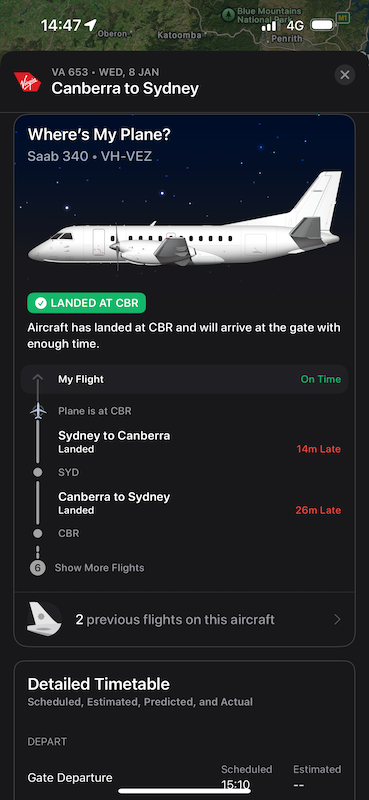
You can easily add or import your past and future flights, and it keeps track of them all in one place. It also keeps track of lots of interesting statistics and data, including the actual flight paths of previous flights you’ve taken and the number of times you’ve flown on a particular aircraft.
While the paid version of Flighty has lots of extra features (such as delay notifications and useful information if you’re connecting or arriving at your destination airport), the basic version is free to use.
Seats.aero
A decade ago, finding frequent flyer reward seats meant using a combination of airline websites, calling the airline or using a tool like Award Nexus or the downloadable KVS Tool.
Over the past few years, a huge number of new tools have been developed that make finding award flight availability much easier. Unfortunately, fewer reward seats are now available – so the search has actually got harder overall. But at least you can now more easily find whatever is out there.
Some of the new tools that make it easier to find reward flights include:
- SeatSpy
- AwardLogic
- Point.me
- Gyoza Flights
- Reward Flight Finder
- Awardhacks.se
- AwardFares
- PointsYeah
- Roame
- AwardTool
- SeatFinder
- FlightSeats.io
- Points Ninja
Many of the above tools do more or less the same thing, and most are useful. But my personal go-to has become Seats.aero.
With Seats.aero, you can easily see – in just a few clicks – all of the dates that currently have reward availability on your preferred route, cabin and frequent flyer program. It shows availability for many useful frequent flyer programs, including Qantas and Velocity.
I’ve previously explained how to use this functionality in a separate guide to Seats.aero.
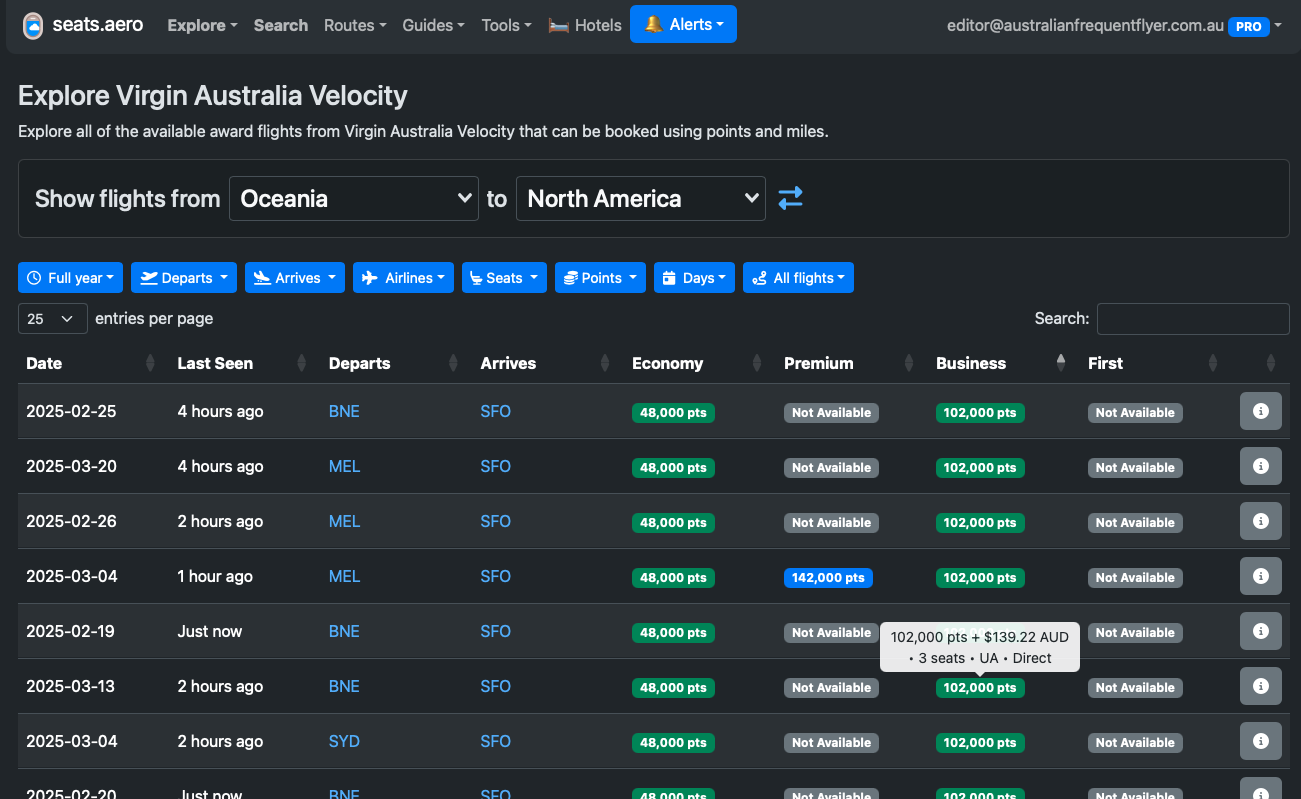
It also has heaps of other useful features, such as fare class availability information, live seat maps and the ability to set alerts. This list is growing.
At the same time, ExpertFlyer’s new owner appears to have stopped investing in its product. ExpertFlyer no longer shows award availability for most airlines and some of its core features regularly stop working.
In my opinion, at some point in the not-too-distant future, Seats.aero has the potential to replace ExpertFlyer as the go-to source of information for frequent flyers.
Rooms.aero
Following the closure of Award Mapper, Rooms.aero has emerged as a useful resource for finding hotel award night availability. Made by the same people as Seats.aero, this works in a similar way to the original website, but for hotel rooms.
AeroLOPA
Seat Guru used to be the “authoritative” source for airline seat maps, with its helpful colour-coded ratings of each seat so you could see which were the best and worst ones.
Since Seat Guru stopped maintaining and updating its seat maps, AeroLOPA has become my go-to resource for accurate airline seat maps. It now has an extensive library covering most of the airlines I would ever fly with, with some exceptions. (For example, I could not find a seat map for my upcoming ASKY Airlines Boeing 737-800 flight.)
Just as importantly, the maps are highly detailed and accurate – down to the exact position of each window. For people who care about small details, this makes it really easy to work out which seat to choose.

FlightConnections
FlightConnections makes it really easy to visually see which routes different airlines fly, and which destinations are served from any airport. It has an interactive map and lots of filters that are really easy to use, and can help a lot with trip planning.
It’s free to use this frequent flyer tool, but some of the advanced features (like filtering by alliance, cabin or aircraft type) require a reasonably-priced subscription, which also removes the advertisements.
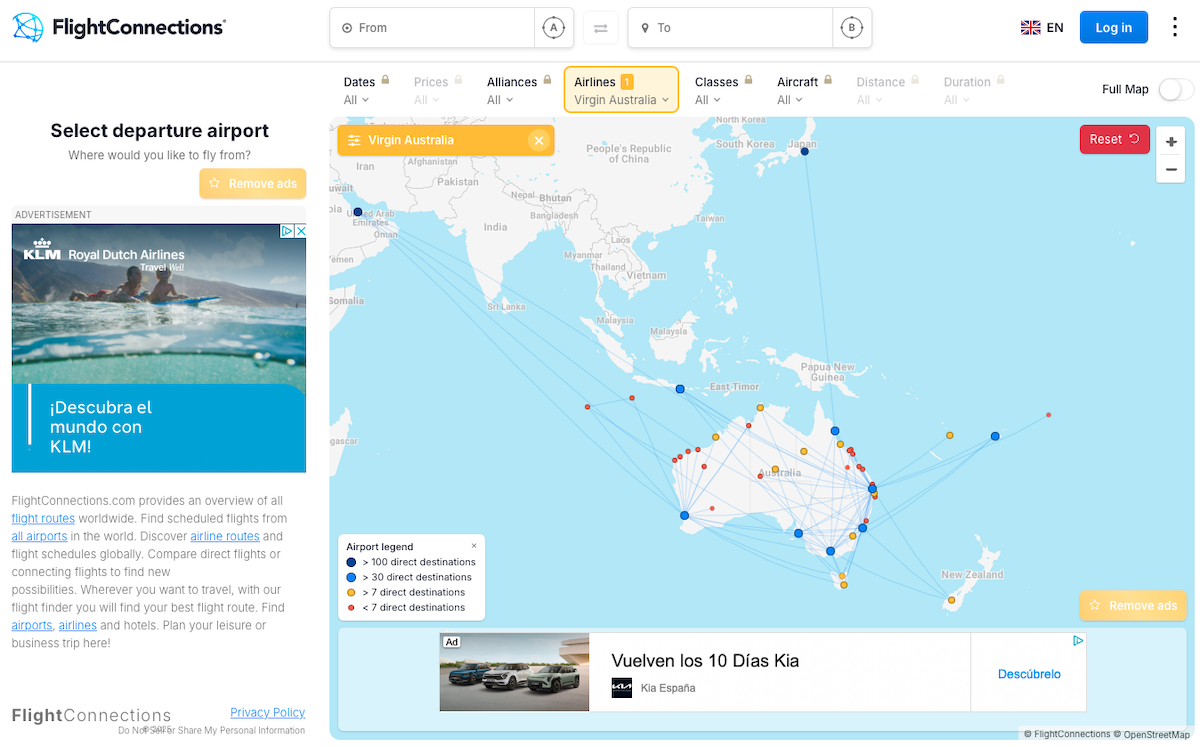
Google Flights
Many people still use online travel agents like Webjet, or aggregators like Skyscanner, to search for flights. Nowadays, I typically just go straight to Google Flights – even if I already have a particular flight or airline in mind for my trip.
Google Flights is not a booking engine, but its powerful features and filters let you easily sort through the best flight options. Its “Explore” mode is particularly good if your destination and dates are flexible.

For more advanced searches, I also sometimes use ITA Matrix (which has the added benefit of showing which fare class you’re booking). That said, I find that the fares shown by ITA Matrix are now sometimes a lot higher than what’s actually available when booking direct with the airline.
Google Hotels
I’ve also been finding Google Travel’s hotel search feature useful lately – mainly for a few of its specific features:
- Ability to filter by brand
- Ability to filter by specific hotel amenities (e.g. you can exclude hotels without a gym or swimming pool, which are both important to me)
- Compare prices of booking direct with the hotel or through other third parties
All things being equal, I generally choose to stay at chain hotels where I have status. That way, I can use the benefits of my status and also earn points and elite qualifying nights. But I don’t necessarily just want to limit my search to only IHG hotels, or only Accor hotels (for example). With Google Hotels, you can simply filter in or out the chains and brands that you want to consider.
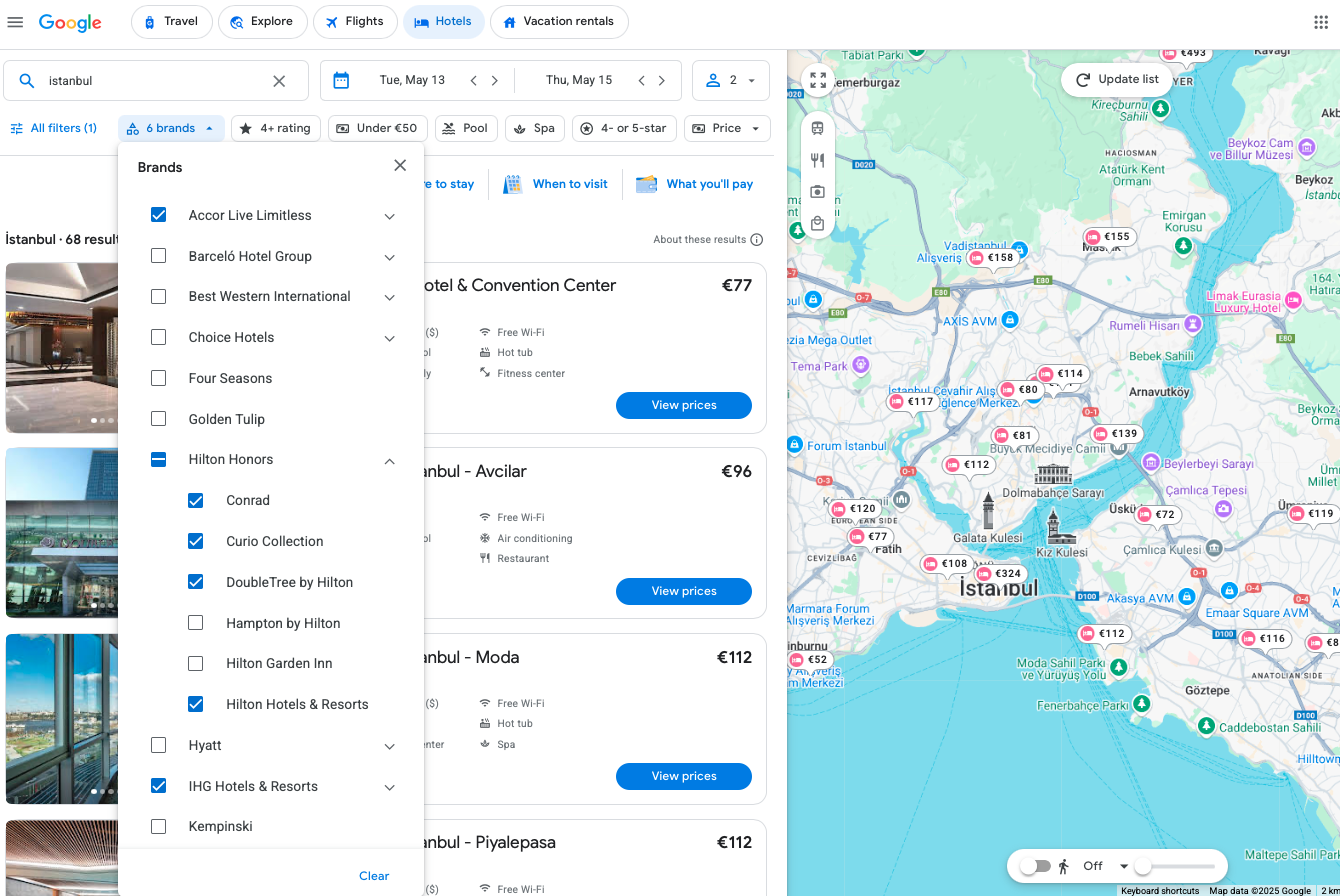
Where to Credit
Where to Credit remains an oldie but a goodie when deciding which frequent flyer program to credit the points to for a particular flight. If you’re unsure of your options, simply enter your airline and fare class to see a list of programs and the rate at which you can earn points.
Flightradar24
Flightradar24 remains the premier resource for tracking flights around the globe. The team has invested heavily in the service, and it shows. It now has coverage in many parts of the world, with lots of added details and features available.
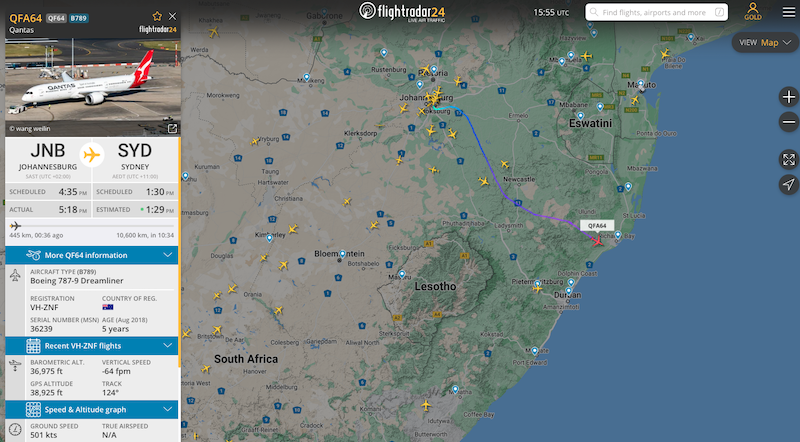
I also regularly use the aircraft tracking feature to see where a plane has been recently or find out which aircraft might be operating my upcoming flight. I also find it useful to see an overview of past flights on a particular route or flight number, as this can help me to predict the likelihood of my flight being delayed.
Sometimes, I even use Flightradar24 to see the exact path taken by a particular flight in recent days in order to determine which side of the aircraft I should sit on for the best view.
Turbli
If you’re a nervous flyer, or just an AvGeek who’s interested in this stuff, Turbli can predict the turbulence you’re likely to experience on an upcoming flight using real-world weather data.

eSIMs (e.g. Airalo)
I used to regularly buy local SIM cards when travelling overseas, swapping physical SIMs in and out of my phone with each border crossing. This worked OK, but it was quite inconvenient to have to go to a shop and buy a new SIM card so often.
With the advent of eSIMs, it’s now so much easier to get access to mobile data at affordable rates when overseas for short periods of time. You can simply download an eSIM to your phone, and activate it as soon as you land in the destination country.
This means you have internet access from the moment you arrive – great if you plan to catch an Uber from the airport. You can also keep your regular SIM card in your phone, so you can still receive calls and text messages.

I typically use Airalo eSIMS – they generally work well and I find the prices reasonable – but there are many other options out there. Note that you need a smartphone that is compatible with eSIMs.
As these eSIMs only give you access to data, you don’t get a local phone number and can’t make phone calls – but there are other services available for that. These days, I typically use Wi-Fi based messaging services like WhatsApp, or Skype for phone calls.
Annoyingly, Skype no longer sells pay-as-you-go phone credit. This means you need to get a subscription that includes calls to specific countries and types of phone numbers.
A good password manager
With loyalty program fraud on the rise, it’s really important that you use a different password for each account and change your password regularly. (If it’s available, two-factor authentication adds another layer of security as well.)
These days, most people probably already use a secure, digital password manager. But if you don’t, you should really consider setting one up. This way, you don’t need to try to remember all of your passwords – something that would be nearly impossible if you use secure passwords that are hard to guess. Or worse, have them all written down in a physical notebook.
While there are many options out there, I personally like Bitwarden as it’s free, secure, open-source and does everything I need. You can add and view your passwords both in the app and by logging into the website.
Frequent flyer tools, websites and apps I’m now using less
Over time, some tools that were previously very useful have become less so. This could be because their developers have stopped maintaining them, their owners no longer see a strategic interest in the product, or simply that newer tools have come along in the meantime that can do a better job.
Several once-useful travel apps including App in the Air and TripCase have recently closed down. So has LoungeBuddy (Loungepedia seems like a decent replacement so far for that).
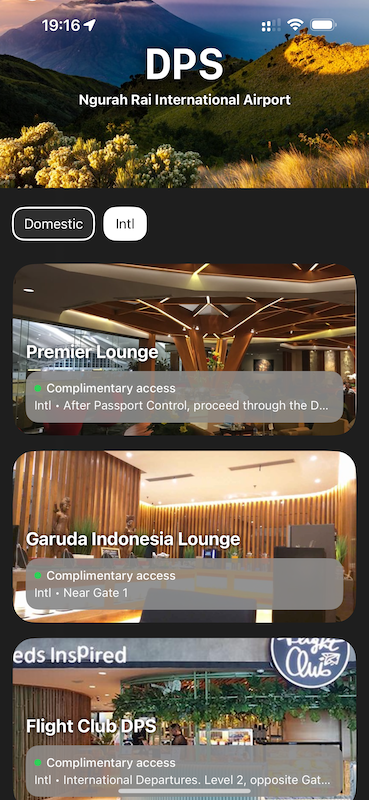
And then there’s CheckMyTrip, which in 2023 released an update that effectively removed the tool’s most useful features. I deleted that app shortly after.
The Stocard app, which stores loyalty cards digitally, has also advised users of its impending closure. The go-to replacement for that seems to be a free app called “mobile-pocket”.
Changes to AwardWallet
I’ve also recently cancelled my AwardWallet subscription. Although I have found it useful for tracking the points in my various loyalty program accounts – and being alerted if they are about to expire – I no longer allow AwardWallet to automatically update most of my accounts. That’s because, as fraud prevention systems get better, some AwardWallet logins have triggered loyalty programs to lock or suspend my account. This has caused me great inconvenience.
I still kept my AwardWallet Plus subscription active until now, as AwardWallet was only charging me USD10/year. But as they recently increased their subscription fee to five times that amount, I didn’t have to think too hard about cancelling. Based on the comments in this AFF thread, many other frequent flyers felt the same way.
Alternatives to Uber
I’ve been using Uber for over a decade. After many bad experiences being ripped off by taxis both overseas and in Australia – something that’s unfortunately still apparently quite common – I like the way Uber has disrupted the taxi industry. When using the app, there is more accountability for the driver and the contactless payment is more seamless.
Overall, Uber has pretty impressive global coverage. But it doesn’t work everywhere, and in some countries there are much better alternatives. For example, I’ve started using Careem in the Middle East as there are many more drivers using it, and the fares seem to be a bit lower. I now use Grab in Southeast Asia and Yandex in Central Asia, rather than Uber, for the same reason. In other markets, apps like Bolt or Lyft might be better alternatives.
Here in Australia, there’s also the DiDi app which typically has lower fares than Uber (of which a higher percentage goes to the driver) and lets you earn Velocity Points.

Unfortunately, there are still some countries without Uber or any alternative ride-share app available. For now, in those places, you’re stuck with the dreaded taxi monopoly.
Summary: Out with the old, in with the new
So, is it time to update the tools in your frequent flyer toolkit?
Here’s a summary of some of the older frequent flyer tools and travel resources that have been replaced by (arguably) better options:
| Old resource | A good replacement | Purpose/function |
|---|---|---|
| App in the Air | Flighty | Keep track of your flights and be notified of delays etc. |
| TripCase | TripIt | Manage your travel itineraries in one place |
| ExpertFlyer | Seats.aero | Find award availability, seat maps and fare availability |
| Older award availability search tools | Seats.aero | Find award availability |
| Seat Guru | AeroLOPA | Find airline seat maps |
| Skyscanner | Google Flights | Search for cheap flights |
| Trivago | Google Hotels | Search for hotels |
| AwardMapper | Hotels.aero | Find chain hotels where you can redeem points for nights |
| Physical local SIM cards | eSIMs | Access mobile data while overseas |
| LoungeBuddy | Loungepedia | Find information about available lounges at each airport |
| Stocard | mobile-pocket | Store your loyalty cards electronically |


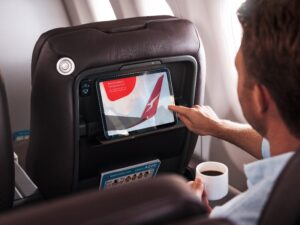
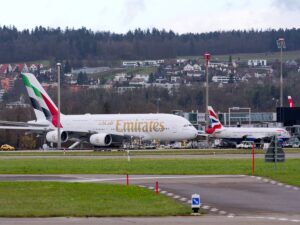


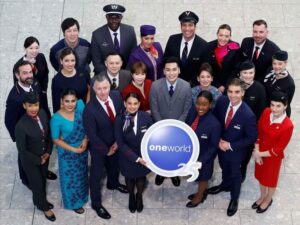
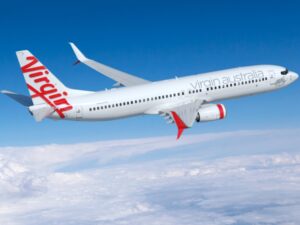

























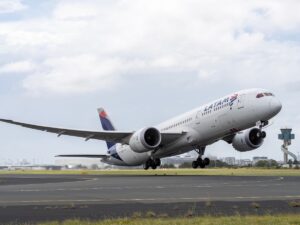



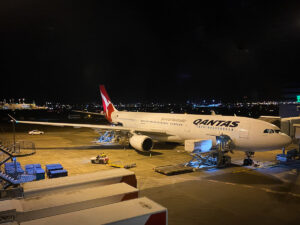






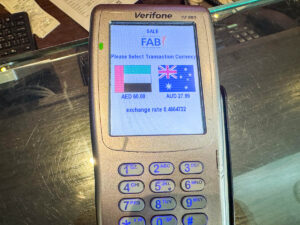





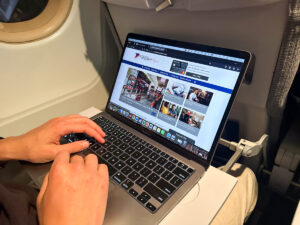






























Community Comments
Loading new replies...
Join the full discussion at the Australian Frequent Flyer →